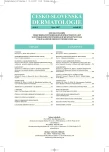Dr. David Gruby (1810–1898)
Authors:
Z. Szép
Authors‘ workplace:
Katedra dermatovenerológie Fakulty zdravotnických špecializačných studií Slovenskej zdravotníckej univerzity v Bratislave
vedúca katedry m. prof. MUDr. Klaudia Kolibášová, PhD.
Published in:
Čes-slov Derm, 82, 2007, No. 5, p. 283-287
Category:
From History
Overview
David Gruby (1810–1898) was one of the most important mycologists of the 19th century who participated in the birth of dermatomycology. Raymond Sabouraud called him “the father of mycology”. He was born in the southern Hungary, started to study the medical faculty in the Pest and graduated in Vienna. He lived in Paris. He was a real generalist; he was interested in microscopy and was the first one who made the microphotographies of specimens. He was the well-known clinician; he used the methods of modern psychosomatic treatment, was interested in astronomy and meteorology and was the pioneer of medical meteorology. He was also interested in surgery and suggested the use of cotton in the wound care. His beneficence and welfare work are also important. In the field of mycology he described the etiological agent of favus, candidiasis and microsporia and the type of hair parasitism: ectothrix and endothrix. He also discovered the parasite of trypanosomiasis (he is the author of the name of Trypanosoma).
Labels
Dermatology & STDs Paediatric dermatology & STDsArticle was published in
Czech-Slovak Dermatology

2007 Issue 5
Most read in this issue
- Cutaneous Amyloidoses
- Mucocutaneous candidiasis and its relation to women’s sexual hormones
- The Importance of Atopy Patch Tests in the Diagnostic Procedure in Patients with Atopic Dermatitis
- Dr. David Gruby (1810–1898)
